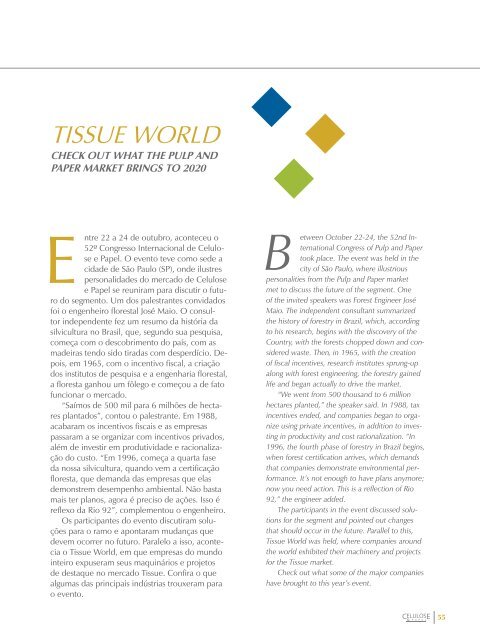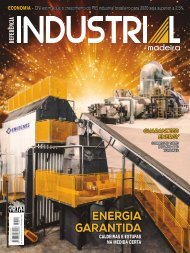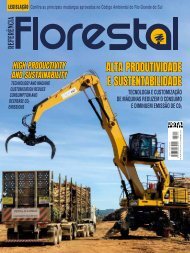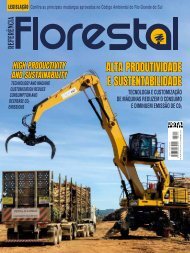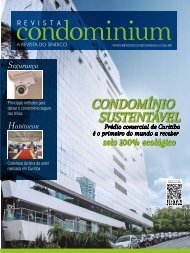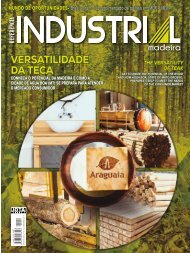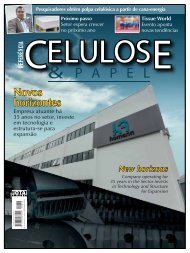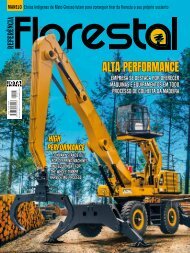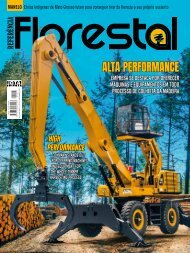Create successful ePaper yourself
Turn your PDF publications into a flip-book with our unique Google optimized e-Paper software.
TISSUE WORLD<br />
CHECK OUT WHAT THE PULP AND<br />
PAPER MARKET BRINGS TO 2020<br />
Entre 22 a 24 de outubro, aconteceu o<br />
52º Congresso Internacional de <strong>Celulose</strong><br />
e Papel. O evento teve como sede a<br />
cidade de São Paulo (SP), onde ilustres<br />
personalidades do mercado de <strong>Celulose</strong><br />
e Papel se reuniram para discutir o futuro<br />
do segmento. Um dos palestrantes convidados<br />
foi o engenheiro florestal José Maio. O consultor<br />
independente fez um resumo da história da<br />
silvicultura no Brasil, que, segundo sua pesquisa,<br />
começa com o descobrimento do país, com as<br />
madeiras tendo sido tiradas com desperdício. Depois,<br />
em 1965, com o incentivo fiscal, a criação<br />
dos institutos de pesquisa e a engenharia florestal,<br />
a floresta ganhou um fôlego e começou a de fato<br />
funcionar o mercado.<br />
“Saímos de 500 mil para 6 milhões de hectares<br />
plantados”, contou o palestrante. Em 1988,<br />
acabaram os incentivos fiscais e as empresas<br />
passaram a se organizar com incentivos privados,<br />
além de investir em produtividade e racionalização<br />
do custo. “Em 1996, começa a quarta fase<br />
da nossa silvicultura, quando vem a certificação<br />
floresta, que demanda das empresas que elas<br />
demonstrem desempenho ambiental. Não basta<br />
mais ter planos, agora é preciso de ações. Isso é<br />
reflexo da Rio 92”, complementou o engenheiro.<br />
Os participantes do evento discutiram soluções<br />
para o ramo e apontaram mudanças que<br />
devem ocorrer no futuro. Paralelo a isso, acontecia<br />
o Tissue World, em que empresas do mundo<br />
inteiro expuseram seus maquinários e projetos<br />
de destaque no mercado Tissue. Confira o que<br />
algumas das principais indústrias trouxeram para<br />
o evento.<br />
B<br />
etween October 22-24, the 52nd International<br />
Congress of Pulp and Paper<br />
took place. The event was held in the<br />
city of São Paulo, where illustrious<br />
personalities from the Pulp and Paper market<br />
met to discuss the future of the segment. One<br />
of the invited speakers was Forest Engineer José<br />
Maio. The independent consultant summarized<br />
the history of forestry in Brazil, which, according<br />
to his research, begins with the discovery of the<br />
Country, with the forests chopped down and considered<br />
waste. Then, in 1965, with the creation<br />
of fiscal incentives, research institutes sprung-up<br />
along with forest engineering, the forestry gained<br />
life and began actually to drive the market.<br />
“We went from 500 thousand to 6 million<br />
hectares planted,” the speaker said. In 1988, tax<br />
incentives ended, and companies began to organize<br />
using private incentives, in addition to investing<br />
in productivity and cost rationalization. “In<br />
1996, the fourth phase of forestry in Brazil begins,<br />
when forest certification arrives, which demands<br />
that companies demonstrate environmental performance.<br />
It’s not enough to have plans anymore;<br />
now you need action. This is a reflection of Rio<br />
92,” the engineer added.<br />
The participants in the event discussed solutions<br />
for the segment and pointed out changes<br />
that should occur in the future. Parallel to this,<br />
Tissue World was held, where companies around<br />
the world exhibited their machinery and projects<br />
for the Tissue market.<br />
Check out what some of the major companies<br />
have brought to this year’s event.<br />
55


